#Genus: Canis
Text
Another puppy Katie vid!!!
#katie may#katie#Videos#phylum: chordata#Class: Mammalia#Order: Carnivora#Family: Canidae#Genus: Canis#Canis familiaris#australian shepherds#blue heelers#herding dogs#working dogs#dogs#mammals#farm animals#my pets
4 notes
·
View notes
Note
wolf? i have never seen you draw wolves (not a bad thing, im just curious how they would look like in your style)

this one maaaaay have gotten a little out of hand. fluffy beast👍
#did you know some experts believe that aussie dingoes are a subspecies of grey wolf?#canis genus im sorry for neglecting u
27 notes
·
View notes
Text
I was looking up the size of wolves, and if you go to images you get a bunch of hunters posing and smiling with dead wolves they've shot. I understand having to shoot a wolf but it seems like a fucked up thing to be happy about. Like, I see that and I just see a very big dog. If you have to kill one you have to but posing with it grinning ear to ear seems kinda fucked.
#I know wolves are not dogs#but it seems fucked up to me to kill any of the canis genus without a good reason#Its a hyper intelligent keystone species you should respect it enough to at least be sad you killed it
8 notes
·
View notes
Text
it fucks me up that cyno has such a strong wolf motif that it suppresses the (more inspiration-accurate) jackal/dog motif. like i actually kinda appreciate the blending together of multiple different canines bc even mythology is often blurry about the distinction of similar but different animals and having both a wild jackal and a domestic dog motif to play with is fun, but the wolf is sooo forced in there. they even went as far as to replace the canis in canis aureus (scientific name of the golden jackal) with lupus. hijacked the dog to make it wolf instead. wolves are also in the canis genus it's fine!!!!!! it's all canis!! always has been!!!!!!!!!!
#side note: golden jackal is in the genus canis but the black-backed and side-striped jackals are in their own genus (Lupulella)#tighnari gets to have just the whole straightforward scientific name for his constellation#good for him. being so uncomplicated#ahhhh i love dogys#like i would have appreciated just a little bit of wolf in there as a treat but its so overpowering...#unsubtle!#as far as im aware there's a whole mess about what exact canid represents anubis but im pretty sure its never just a whole ass wolf#and a quick skim of some wikipedia articles tells me that the canine in question may not actually be exactly a jackal either but we already#call like three different animals jackal so who's counting
5 notes
·
View notes
Text

Fun fact: Dire wolves were actually not wolves, as a study in 2021 shows this large and very common Pleistocene dog was actually part of its own genus, Aenocyon, not Canis. Some of its modern day relatives are notable for more reddish fur and even within Canis the integument can vary quite a bit. That's why I showed the animal here not as wolf like as it is usually depicted.
563 notes
·
View notes
Note
So since dogs, wolves, and coyotes can interbreed and have viable offspring are there any other canids that can? Not saying we should let them or anything. Completely against wild and domestic animals interbreeding. It's just so interesting that these three species can when most hybrids are infertile.
So theoretically, most species in the Canis genus could interbreed. Gray wolves, red wolves, eastern wolves, and dogs have all hybridized at some point with coyotes. Dingoes and golden jackals have hybridized with dogs so they could theoretically make viable offspring with coyotes and wolves. African golden wolves and Ethiopian wolves are in the same genus, so they could also potentially cross with the others (though I don't believe I've seen any confirmed examples of either).
Here's some examples of various hybrids:
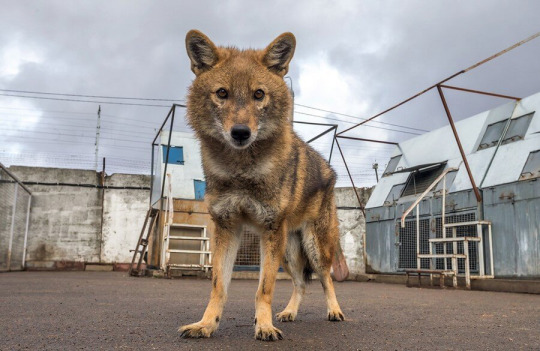
Sulimolv dog - A golden jackal x domestic dog. The initial pair were Lapponian Herders crossed with golden jackals.

Dingo-dog. Because of ongoing interbreeding of dingoes and domestic dogs, there is a wide range of colors and body shapes today among the Australian wild dog populations.

Golden jackal x feral dog in India.
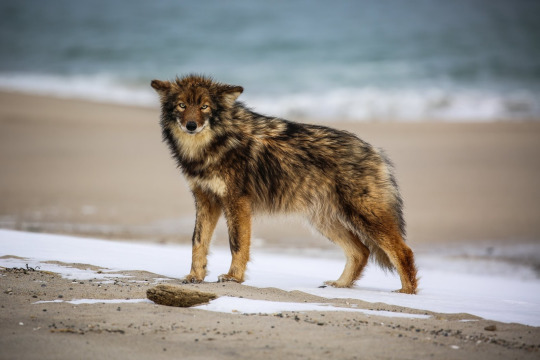
Coyote x long-haired dog breed.

Eastern coyote (Canis latrans "var.") - Predominantly coyotes but have traces of gray wolf, eastern wolf, and domestic dog.
3K notes
·
View notes
Text




Carnivoran skulls from the Florida Museum of Natural History:
Lesser short-faced bear (Arctodus pristinus). Became extinct around 300,000 years ago, fossils are found in high concentrations in Florida. Related to the modern spectacled bear.
Ambruster’s wolf (Canis ambrusteri). Became extinct around 250,000 years ago, found throughout the United States. Taxonomy of this species is somewhat confusing, it may be related to modern grey wolves but may also be ancestral to dire wolves (which are now placed in the genus Aenocyon).
American lion (Panthera atrox). Became extinct around 11,000 years ago, found from Canada and the United States to southern Mexico. American lions were the sister species to Eurasian cave lions and are closely related to modern lions.
Sabertooth cat (Smilodon gracilis). Became extinct 500,000, had a fairly cosmopolitan range throughout North America and parts of South America. S. gracilis is the smallest Smilodon species and is believed to be the ancestor of S. fatalis and S. popular or. Sabertooth cats are not closely related to any modern species of cat.
#natural history#paleontology#florida museum of natural history#short faced bear#extinct wolf#smilodon#sabertooth#american lion
446 notes
·
View notes
Text
Dacshbun Facts

(Art by ktyon3 on Danbooru)
-The genus name for the Dachsbun line is "Panemis Canis." Panemis comes from the old words "Panis" and "Panem, " which both mean bread. Canis is the genus name for canine pokemon. The rough translation for the Dachbun line is "bread dog"
-Dachbun have been with humans for centuries, and are diverged from the Stoutland line and are close relatives of the Slurpuff line
-Dachsbun and Fidough were common Pokemon in Kalos until a civil war that left everyone hungry, when all of them were killed as they were accused of eating all of the bread
-Dachsbun sustain themselves on foods with high sugar as that’s what the yeast in their body needs to keep thriving
-If you have a Dachsbun who just had a litter of Fidough, you might notice they become more aggressive and clingy around them. This is completely normal behavior! Since Fidought hatch too soft for their own good, Dachbun mothers will cuddle around them because the warmth of their body hardens them out
-Dacshbun are the most common evolved pets in Paldea
-Dachsbund were actually bred in a region near Paldea where they were used as hunting dogs. The word Dach actually means badger, since they were used to hunt mustelids (like Furret). They became friendlier and more bread like with the rise of agriculture
-Dachsbun are slightly warm to the touch and make great cuddle buddies

-A lot of people assume they they're like Appletun, where you can pick the pieces off and eat them. Don't do this! That can harm the Dachbun, and unless it's cooked, they're not edible!
-Anyways, yeah. Dachbun can be cooked and eaten
-They pair really well with Growlithe and Arcanine because of their well-baked body and Growlithe/Arcanine's heat
-Despite their body looking and feeling like bread, they still have really short fur all over them (the yellow parts being the exception; the fur is obviously longer there)
-While it might look like their toes are just regular dog toes, those are actually holes in its body! The slits in their toes help them get rid of excess yeast that would cause air bubbles to form
-Daschbun are sometimes nicknamed "Baguette dogs" for their long bodies
-Like fidough, Dachbun still don't have great hearing, so they have a great sense of smell to make up for it
#//region mentioned is a german based region#quill pokefacts#pokemon#pokemon irl#irl pokemon#pkmn irl#irl pkmn#pokeblog#pokeblogging#rotomblr#pokeblr#rotumblr#pokemon roleplay#pokemon biology#pokemon biologist#daschbun#fidough#fairy type#fairy types#fairy type pokemon#pokemon scarlet ans violet#pokemon scarlet#pokemon violet#pokemon sv#pkmn#pokeblogging roleplay
130 notes
·
View notes
Text
Lupulella mesomelas
Until recently, jackals were in the Canis genus with wolves and coyotes. They are now in their own genus called lupulella, which consists of only two species- the side-striped jackal and the black-backed jackal. Golden jackals aren’t included in this genus because recent studies have shown that they are more closely related to grey wolves than to other jackal species.

The smallest jackal species is the black-backed jackal, found in Southern and Eastern Africa. They weigh roughly 13 to 20 pounds (5.8 to 9 kg) and are named after their distinctive “saddles,” or dark-colored bands on their backs.
Black-backed jackals are quite social. Most of them do almost everything in pairs, including hunting, digging dens, and raising pups, and they often form small family groups or packs. Because they are often hunted by leopards, eagles, and especially hyenas, which are much larger than them, groups of jackals are often more successful in raising pups and guarding their food.

Jackals usually target small animals like lizards, rodents, and hares, but groups of jackals will target impala, wildebeest calves, and other larger prey. They also eat insects and vegetation like plums and figs.
Although they are regularly hunted for their fur and by farmers and ranchers protecting livestock, black-backed jackals are classified as least concern. This means they are quite common and are not in danger of extinction.
I rate the black-backed jackal 12/10. Their ears are the perfect size
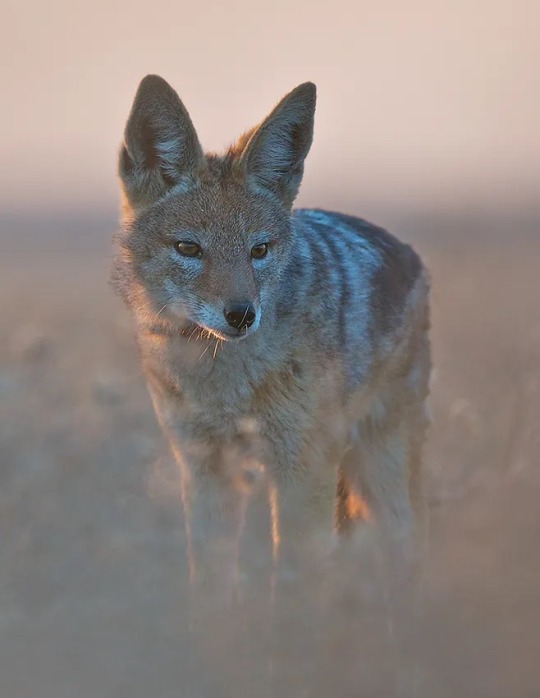
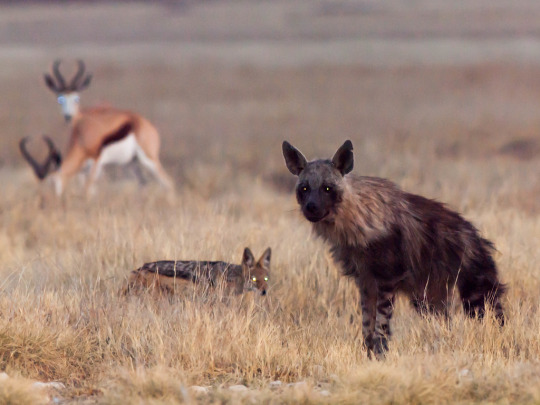
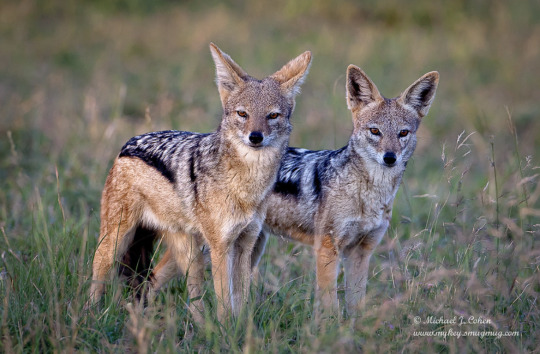
Photo credits:
(1) Thomas Reich (2) Sean Crane (3) Sean Crane (4) Chris Hartzell (5) Michael Cohen
#jackal#jackals#black backed jackal#black-backed jackal#canine#canines#animals#biology#nature#science#wildlife#zoology#animal#dog#dogs#wild#african animals
519 notes
·
View notes
Text
JTTW Chapter 36 Thoughts
Chapter 36 for the @journeythroughjourneytothewest Reading Group!
We’ve got creatures galore this time around!
Why can’t you give us the slice of life, huh? Why can’t you, the people want to read fluff too! I know I’d love to.
So as I’m attempting to keep track of the passage of time stated in the text there seems to have been a timeskip of multiple years. The changing of seasons up until last chapter only indicated around one and a half years passing, so either Tang Sanzang is exaggerating and only half a year to one year passes, so definitely one Winter since the narration mentioned frost, or it’s really been a couple of years.
Deer, deer, deer! No fallow deer, those are muntjac deer in the Chinese Original. Cute in the silliest way.

River deer basically yes, our lovely goofy Chinese Water Deer.

Now hold it! Those are not wolves! In the Chinese Original they are either Dholes or a kind of jackal. All three are in the family of Canidae. The wolf shares the Canis genus with jackals, while dholes and jackals are of the same tribe Canini.
I’m leaning more towards Cuon Alpinus so Dholes, which range throughout Asia and are also called Red Wolf or Mountain Wolf, but that might also be personal bias for I watched the Wild Kratts episode on them.

They are really social even more so than wolves and just overall very sweet. However they are classed as endangered!
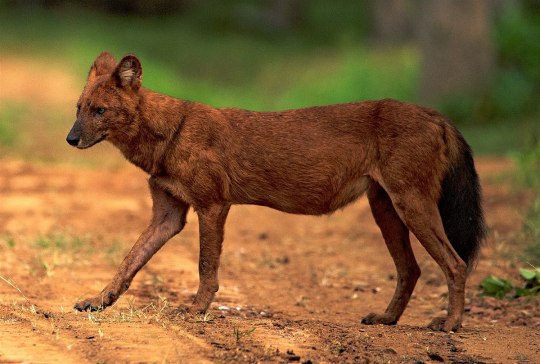
They also come in a fluffy variant.

Jackals are really neat too though, here it might specifically be the Canis Aureus commonly known as Golden Jackal, which are native to Eurasia.
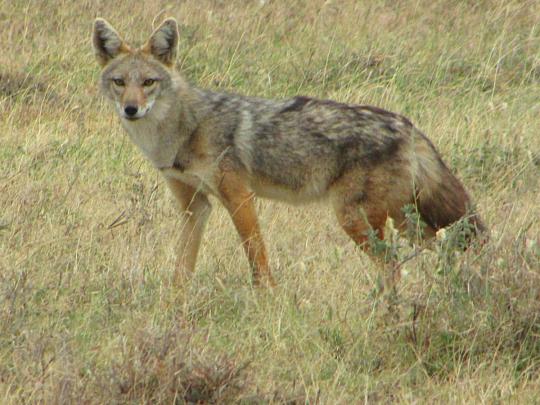
From Anthony C. Yu’s notes I concur the Vajra-guardians definitely do not look like cherubs neither the modern version nor the biblically accurate one. But they might be somewhat similar in function! Cherubim are assigned to protect special places as one of their jobs, so that guardian function might be the similarity that led to the comparison.
Tang Sanzang getting pouty is so endearing, much more than any ‘scared of demon’ instance.
Though in my opinion the monastery should have been able to kick out those guys that were causing needless trouble over multiple years. Give aid to fellow people yes, but if they knowingly and wilfully act out like that they rescind their right to stay.
Again with the property damage, Sun Wukong might have already cut down on violence against people, but no door is safe from him still.
#xiyouji#journey to the west#jttw#wild kratts#sun wukong#monkey king#tang sanzang#jttw reading group#jttw book club#deer#muntjac deer#chinese water deer#dhole#Cuon Alpinus#jackal#Canis Aureus
15 notes
·
View notes
Text
— Quitherianthropy
From the latin words quidam, aliqua, and quis, collectively meaning ‘some,’ especially aliqua; ‘some, by some way or other’
— Definition of Quitherianthropy
“ Quitherianthropy is a subcategory of therianthropy in which a therian does not identify as a distinct species, nor holds a broader identity encompassing an entire genus or family (cladotherianthropy). They are somewhere in between, identifying as all or most species of a specific animal. ”
— Examples of Therianthropy, Cladotherianthropy, and Quitherianthropy
“ Instead of just a single species, e.g. an arctic wolf therian, or an entire genus/family, a canis or canidae cladotherian, a wolf quitherian identifies as all or most species of wolf; gray wolf, red wolf, coastal wolf, arctic wolf, etc., all at once. When it comes down to appearance, the quitherian may believe they are all possible coats of each species, or have a specific colored coat from each species. ”
— Where did it come from?
The term was created by strayhounds (me!) on Tumblr (it/its) after it felt its experiences did not align with normal therianthropy, nor the classic definition of cladotherianthropy. Wanting to create a label that described its experiences in more detail, it coined quitherianthropy in April of 2023.
— Quitherianthrope Flag

#quitherianthropy#quitherian#quitherianthrope#therian#therianthropy#therianthrope#otherkin#otherkinity#otherkind#otherhearted#— ☾ . * ✦ coining
134 notes
·
View notes
Text
An older video of puppy Katie!!
#katie#katie may#Videos#phylum: chordata#Class: Mammalia#Order: Carnivora#Family: Canidae#Genus: Canis#Canis familiaris#Australian shepherds#Blue heelers#Herding dogs#Dogs#Mammals#My pets
5 notes
·
View notes
Text

The Fuegian dog (Spanish: perro yagán, perro fueguino), also known as the Yahgan dog, is an extinct domesticated canid. It was a domesticated form of the culpeo (Lycalopex culpaeus).[1] The culpeo is similar in build to true foxes (tribe Vulpini) but is actually more closely related to wolves and jackals, being placed in a separate genus within the South American foxes or zorros. The Fuegian dog is not descended from domestic dogs, which were domesticated from an ancestor shared with the modern gray wolf (Canis lupus), nor from the domesticated silver fox which was domesticated from a melanistic population of the red fox (Vulpes vulpes).
Although the distribution of the Fuegian dog corresponded with that of the Yahgan people, individual animals were not loyal to their human owners. Julius Popper pointed out the canid's lack of loyalty: "I never saw them, no matter how large their number, take an aggressive attitude or defend their masters when these were in danger".[4]
Fuegian dogs were not used to hunt guanaco. However, they might have been useful for hunting otters.[3] The foxes were also useful to humans in that they would gather around their owners to keep them warm. This was noted by Julius Popper: "The dogs placed themselves in a group around the small Onas, taking the shape of a kind of wrapping .... [M]y opinion is that the Fuegian dogs are only useful to complete the defective garment of the Indian, or better, as the Ona's heating furniture".
In 1919, when Silesian missionary Martin Gusinde visited the local Yahgans, he noticed that, to his knowledge, all of the dogs seemed to be missing. He immediately noted this as odd, especially considering that the tie between the dogs and the local people was well documented by foreign missionaries and explorers by this time. Indeed, this mutual cooperation allowed for the region to become the only stronghold of this unusual domesticated canine to have ever existed. Upon speaking to the local people and inquiring about what had happened to the animals, he was told that the entire known population of them had been exterminated, and it was claimed they "were dangerous to men and cattle". Apparently, this "fierce" nature of the animal was allegedly witnessed by Thomas Bridges in the 1880s, who in his writings, purported that the dogs attacked his mission's goats, while giving few specific details.[5]
1919! your great-great-grandma could have seen them!
48 notes
·
View notes
Text
Houndour & Houndoom
Houndour (#228)
Canisinfernis fidelis
Houndour are social Pokémon that form packs with others of its kind. In this world, Houndours and their evolution are substitutes for coyotes.
Houndour average at 2 feet tall (0.6 M) and 23.8 pounds (10.8 kg). They are small lads.
Habitat: The grasslands, cities, and mountains of Turtle Island/the Americas. They are incredibly versatile in the habitats that they can live in, and have recently become increasingly common in urban areas.
Life Cycles: Houndours are born in early April to average litter sizes of 6. They are entirely dependent on their two parents for food and shelter until they’re old enough to leave the nest around August timeframe. Whether or not they actually do leave their parents is a different matter. Some do, some don’t. Their family structures are fluid in these regards, with packs forming from parental pairs and their offspring, and often with siblings or even unrelated Houndours. A Houndour is usually reproductively mature come the following mating season in January/February (so long as it has reached level 15). An individual usually reaches adult proportions around September, which is often when they achieve level 15, too.
As grown Houndours, individuals may stay with their parents to patrol territory and help in hunting, or they may move on to claim their own territory. It is rare to see Houndours outside the structure of a pack.
Behavior: Houndours form packs with others of its kind, sharing immense loyalty to each other and communicating in a refined language of barks and howls. Their teamwork is considered unparalleled, and a pack of Houndours is a highly effective force not to be reckoned with. This loyalty and intelligence lends them to being excellent companions to humans, especially those with great need for a Houndour’s intellect. In high-density urban areas, Houndours have even been known to take the subway!
They communicate with each other using a refined series of barks and howls. Barks are used for determining the location of pack members, especially during a hunt, while howls are a declaration of territorial ownership.
Diet: Houndours are carnivores with a tolerance for omnivorey when necessary, giving them dietary flexibility in urban environments. When they work together, they’re able to take down prey much larger than themselves like Deerling, but they often scavenge the meals of larger predators like Stoutland.
Conservation: Least Concern with some sub-populations being Threatened.
Relationship with Humans: Houndours and Houndooms have a mixed relationship with humans. On one hand, they are treated as invaluable companions that are both loyal and have the intellect necessary to be useful to humans. On the other hand, their intellect makes them seen as wily, conniving, tricksters by many. All things considered though, Houndours and by extension Houndooms had an overall positive/mutually-respectful relationship with the Indigenous Peoples of Turtle Island (the Americas).
In modern times, when anti-predator sentiment rise in folks, Houndours are often high on the list of creatures that rural American farmers want the right to dispose of as seen fit on their own terms. Like coyotes in the real world, Houndours are given the short end of the stick in terms of environmental protections, and they’re generally treated as nuisances and vermin. Their high intelligence not doing them favors in these regards.
Because of the prejudice toward Houndours and Houndooms and dark-types in general, many municipalities do not even consider them for viable starter Pokémon for new trainers, despite their high intelligence and deep loyalty.
Classification: The genus “Canisinfernis” is a combination of “Canis” and “Infernum” (hellfire in latin), and “fidelis” means “loyal”, which in total means “Canisinfernis fidelis” means “loyal hellhound.”
Houndoom (#229)
Canisinfernis canisinfernis
General Information: Houndoom is the evolved form of Houndour. In their guts are a series of toxins that it uses to produce poisonous fire. This gives its flame-breath a foul odor, and allows it to leave burns on foes and prey that are difficult to heal. Its howls are bone-chilling, known to induce shivers in other Pokémon and sending them scurrying back to their nests.
It has a Mega Evolution.
The species averages at 4’7 feet tall (1.4 M) and 77.2 pounds (35 kg), while Mega Houndoom is 6’03 feet tall (1.9 M) and 109.1 pounds (49.5 kg)
Habitat: The same places as Houndours, especially rough terrain areas.
Life Cycles: Houndooms form monogamous pairs that will extend multiple mating seasons. If their pack is a parental pair and their children, it will be the Houndooms who reproduce, but should the pack structure follow a different dynamic, it could be any combination of Houndours and Houndooms who reproduce. Houndooms are loyal, co-operative parents. Males will go out hunting while the females stay behind to raise the Houndour puppies.
Houndooms are known to live for about 20-25 years in captivity.
Behavior: Houndooms are great parents and pack leaders. In a pack, the Houndoom with its horns raked sharply toward the back is the leader of the pack, which is determined by fights for dominance within the pack.
Diet: Houndooms are largely carnivorous but has a mild tolerance for omnivorey.
Conservation: Least Concern, but some sub-populations may be Threatened.
Relationship with Humans: Houndooms are most common as companions of gangs and mafias, since they are most likely to look past their appearance and see them for the valuable companions that they are. This, unfortunately, only contributes to the bad rep that Houndooms receive in the general cultural conscious. Even when European settlers were first exploring the Americas, they likened Houndooms to be servants of the devil and their howls from the grim reaper directly, and that perception hasn’t really changed for a lot of people. Houndooms are also misused in dog-fighting rings, to the great detriment to their cultural perception, and to the outrage of Pokémon Activists and Houndoom Trainers everywhere.
In pop media, if the writers want to quickly convey that a trainer is an intimidating sort, giving them a Houndoom is an easy way to do this—though anyone with a Houndoom of their own will tell you that they’re loving companions who want belly-rubs and treats for being good boys as much as any other dog Pokémon.
Classification: Houndoom are in the broader canids with other dog Pokémon.
Evolution: Houndour evolves into Houndoom at level 24.
~~~~~~~~
Hey guess what, if you like my stuff, this is my website where you can find other Pokémon I've written on and more information about the game that I’m slowly making! Check it out! I write books sometimes too.
#houndour#houndoom#mega houndoom#pokemon#pokemon biology#pokemon biology irl#pokemon irl#pokemon biology irl tabletop#pokemon tabletop#pokemon irl tabletop#tabletop homebrew#homebrew#ttrpg#tabletop#gen 2#pokemon gen 2#gen 2 pokemon#dog days of summer
30 notes
·
View notes
Text
I’m going to be honest, if people actually cared about researching “domestication syndrome” or whatever, they should have taken the wild version of an already domesticated animal and tried to replicate the domestication process. Like wolves, but it would be much easier and more ethical to use wild rock doves, though the problem of most wild populations having been crossed with feral domestic pigeons is certainly present. To deal with that though it may be best to simply use another species of the genus as a model animal. Pigeons are overall a good model since they breed readily and often, and it takes a lot for consanguinity to become a problem (by which I mean pigeons breeding their cousins isn’t a problem for their genetic stability in most cases, breeding to their direct siblings or parents however does of course cause issues).
The Russian fox experiment is faulty and relied on breeding captive foxes that were already bred to have specific traits for a few centuries. Despite this they claimed that these traits were a sign of domestication. If they really wanted to approach foxes honestly, they would’ve needed to use wild individuals. I could see coyotes working easier than foxes since they’re a lot closer genetically to dogs and wolves which would be a closer parallel to the thesis, but obviously an American canine may not have been readily available. To that end though there are certainly Canis species in Europe that could’ve been studied.
It just seems they chose foxes for dubious reasons.
59 notes
·
View notes
Note
I'm scared to share Wolf Fun Facts because I'll feel stupid (or like im treating you like YOU'Re stupid) if you already knew the fact 😓 here goes nothing...
it's actually a Not wolf fun fact but in early 2021 genetic analysis suggested that the "dire wolf" may closely match gray wolves anatomically because they just so happened to both evolve that way... independently of each other.
To note: the average "dire wolf" was the same size as the bigger subspecies' of gray wolves today-- their size is greatly exaggerated in fantasy. They didn't have identical proportions to wolves however; with larger skulls, thicker necks, and smaller paws.
"Dire wolves" and ancient gray wolves were not related-- the "dire wolf" is not even of the genus Canis.
Its updated name is Aenocyon dirus, which was actually proposed but largely rejected as its name 100 years before its recent revival and acceptance, and multiple subspecies have been identified. Its closest living relatives are African jackals, and many paleoartists color and pattern Aenocyon dirus similarly due to their apparent shared niche in warm regions.
They preyed upon a few select megafauna, whereas gray wolves hunted a variety of animals that were usually not as large and were more omnivorous-- this is regarded as the reason for the skeletal (and presumably muscular) differences between the two species.
This is also regarded as one reason as to why wolves survived the ice age and Aenocyon did not-- they were better able to adapt with the mass extinction of megafauna as the last glacier period receded because they were already more flexible in their diets. Skeletal evidence demonstrates increasing malnutrition in "dire wolves" over time.
Locations and frequencies of fossils, alongside the close anatomical match, still suggest that "dire wolves" lived similar lifestyles in similar social structures to gray wolves, though in larger packs, despite differences.
Their closest common ancestor evolved in the Americas around 6 million years ago-- for reference on how far removed that ancestor is, the oldest known Aenocyon fossil is 0.25 million years old. One population migrated to Eurasia and the other remained in America. The Eurasian population came to yield the ancient gray wolves from which the modern gray wolf is descended. The American population, meanwhile, gradually gave rise to the "dire wolf".
One (1) "dire wolf" fossil has been found in Asia, suggesting that a very small population of them migrated from the American continents.
A population of the gray wolves eventually migrated to the Americas and lived in loose competition with Aenocyon until the latter went extinct.
Also, another canid called Xenocyon entered North America just before the emergence of "dire wolves" and was the same size, but their fossils on the continent are rare, suggesting Aenocyon very quickly outcompeted them. Xenocyon would later bring about dholes and African painted dogs in Eurasia and Africa.
here's to hoping you didn't know at least something here because much of it is very recent 🥂
!!! i didnt know ANY of that! woah!! convergent evolution is awesome. i always just assumed dire wolves were ancestors of grey wolves. awesome fact ty for informing me!!!! *_*
59 notes
·
View notes